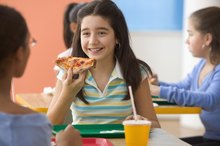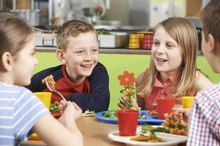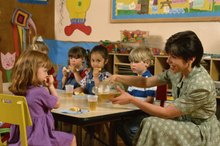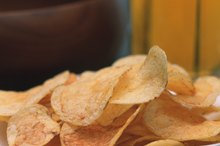How Does Food in Class Affect Children in School?
If you’ve ever tried to complete a task on an empty stomach, you understand the critical connection between nutrition and concentration. Still, even though studies show a direct correlation between healthy eating and focus on learning, many students leave the house in the morning with rumbling stomachs or skip lunch, hoping to sneak in snacks throughout the day. Despite this, widespread allergy concerns, rising obesity rates and budget cuts are forcing some school districts to clamp down on allowing food and drinks in the classroom, while other schools may encourage healthy snacking to promote learning.
Negative Effect: Allergies
Life-threatening peanut allergies are typically the No. 1 reason schools forbid food in the classroom. According to the National Peanut Board, food allergies of all types affect approximately 4 to 6 percent of school-age children. While some students develop a rash or stomach pain from being exposed to nuts, other students may experience anaphylaxis, a systemic bodily response which can be potentially life threatening. Also, because nut proteins are often food in other foods, school districts across the country have taken drastic steps to eliminate all foods in classrooms.
- Life-threatening peanut allergies are typically the No.
- According to the National Peanut Board, food allergies of all types affect approximately 4 to 6 percent of school-age children.
Negative Effect: Distraction and Mess
The Advantages & Disadvantages of School Canteens
Learn More
If you’ve ever tried to concentrate or watch a movie while someone sitting close to you was gnawing on a crunchy snack, you know how distracting food can be. This is another reason schools tend to outlaw classroom eating. The smells of certain foods may bother some students, or amplify hunger pangs in other, snack-less students. Moreover, eating in class can create messes and disrupt the learning process.
- If you’ve ever tried to concentrate or watch a movie while someone sitting close to you was gnawing on a crunchy snack, you know how distracting food can be.
- The smells of certain foods may bother some students, or amplify hunger pangs in other, snack-less students.
Positive Effect: Energy and Focus
Giving students a short break to allow them to eat a healthy snack can help to encourage concentration and reenergize tired students. Snack breaks can be especially helpful for high school students who are on block schedules, have unusually long class periods, such a labs, or who eat late lunches. In addition, school-sponsored breakfasts or snack breaks can help students perform better on standardized tests.
Positive Effect: Camaraderie
Why Am I So Tired After Eating?
Learn More
Class parties with food can promote healthy learning and encourage peer interaction. For instance, celebrating a student’s birthday with cupcakes or other treats can help students feel welcome and excited to be a part of a class. For older students, preparing a theme-based party as a class project, such as a party related to a novel being read in class, can allow students to think creatively while learning and having fun.
Related Articles
References
- MNT: Don't Let Your Child Skip Breakfast
- CDC: Guidelines for School Health Programs to Promote Lifelong Healthy Eating
- Samford University. Disability resources.
- University of Alaska Anchorage. Disability support services.
- Diablo Valley College. Disability support services.
- Barry University. Glenn Hubert learning center.
- Beacon College. A quick guide to Beacon College.
- DePaul Division of Student Affairs. Students with disabilities.
- Anderson University. Disability services for students (DSS).
- Iowa State University. Welcome to student accessibility services.
- American International College. Center for accessibility services and academic accommodations.
- Boston University. Disability and access services.
- Lesley University. Disability services.
- Finlandia University. TRIO student services.
- Augsburg University. Class disability resources.
- St. Catherine University. Disability resources.
- Creighton University. Disability services.
- Centenary University. Project ABLE program.
- Centenary University. STEP Ahead program.
- Fairleigh Dickinson University. Regional Center for Learning Disabilities.
- Adelphi University. Learning Resource Program.
- Alfred University. Fred Gertz Center for Academic Success.
- Iona College. College Assistance Program.
- SUNY Cortland. Adapted physical education community programs.
- SUNY Cortland. Disability resources office.
- Mount St. Joseph University. Project EXCEL.
- Kent State Tuscarawas. Student accessibility services.
- Clarion University. Disability support.
- Community College of Allegheny College. Programs for students with disabilities.
- College of Charleston. Center for disability services/SNAP.
- Baylor University. About OALA (Office of Access and Learning Accommodations).
- The University of Texas at Austin. Services for students with disabilities.
- Northern Vermont University. Disability services FAQ.
- Landmark College. The college of choice for students who learn differently.
Writer Bio
As a mother, wife and recovering English teacher, Jennifer Brozak is passionate about all things parenting and education. A graduate of the University of Pittsburgh and St. Vincent College, Jennifer writes features for the IN Community magazine network and shares her daily escapades on her blog, One Committed Mama.








